The First Crusade culminated with the capture of Jerusalem in 1099 AD. In the following years, pilgrims from Europe tried to make their way to Jerusalem, but were frequently attacked. So several knights decided to join together to protect pilgrims. They were called the Knights Templar because their headquarters were on Jerusalem’s Temple Mount, where the Temple of Solomon had been; they were sometimes called the Order of Solomon’s Temple, or simply Templars.
Over the next two centuries, the power and wealth of the Templars grew. In the early 1300s, they became a juicy target for a cash-strapped French king. The Templars were persecuted in France, and disbanded by the Pope.
The Freemasons inherited some of their customs from the Templars, and some of their customs from the medieval guild of masons. Like the Templars, the Freemasons were associated with Solomon’s Temple, and many Masonic Lodges display Edward Poynter’s painting, The Visit of the Queen of Sheba to King Solomon.

One order of Freemasons was called the Knights Templar. The Freemasons had secret initiation ceremonies not unlike those of the Templars. A secret can help to build a sense of identity — for an organization or for an individual. But people outside the organization may become suspicious of its secret doings, rumors may spread, persecution may result. Both Templars and Masons suffered persecution.
In an earlier issue, I pointed out that Mozart’s Magic Flute is called “The Freemason Opera.” Mozart was a Mason, as was Schikaneder, who wrote the libretto for The Magic Flute. The number three figures prominently in Freemasonry and in The Magic Flute. “The opera begins and ends on the same three chords, there are Three Ladies and Three Boys, and three doors to the Sun Temple.”
The Shakespeare monument in Westminster Abbey also emphasizes the number three. In the image below, note the three-line inscription at the top, the three books in the middle, and the three heads at the bottom:

The poet Alexander Pope, who was a Freemason, wrote the inscriptions on the Shakespeare monument. The WestminsterAbbey website says that the monument was erected by the 3rd Earl of Burlington (among others); Wikipedia calls Burlington “an important Freemason.”
As the number three is important in Masonry, so the letter T is important in Masonry. The letter T has three points, and in many languages (including English) the word for the number 3 begins with the letter T (three, trois, tres, etc.). A Masonic symbol called the Triple Tau, or “key to the treasure” (clavis ad thesaurum) is made up of three Ts:
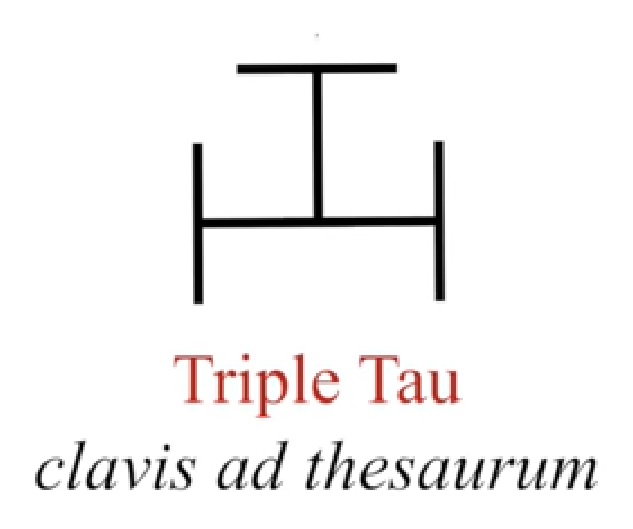
A fourth T is concealed within the Triple Tau. This fourth T is an upside-down T, shown in red below:
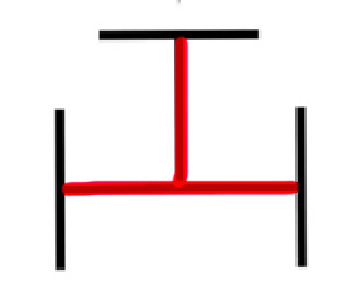
Later we’ll see Shakespeare symbolized by the fourth T, an upside-down T.1A
If T represents three, then three Ts can be thought of as “three times three,” just as the Shakespeare monument has three sets of three, or three times three. We find “three times three” in the following Masonic ceremony:
| High Priest: | Companion Captain of the Host, are you a Royal Arch Mason? |
| Captain: | I am, that I am. |
| High Priest: | How shall I know you to be a Royal Arch Mason? |
| Captain: | By three times three.1B |
Notice how the Shakespeare monument depicts the poet with his right elbow bent and his legs crossed. Knights Templar are also depicted with right elbows bent and legs crossed. The knight below can be found at the Temple Church in London, headquarters of English Templars:

Here’s another knight from the Temple Church, right elbow bent, legs crossed:
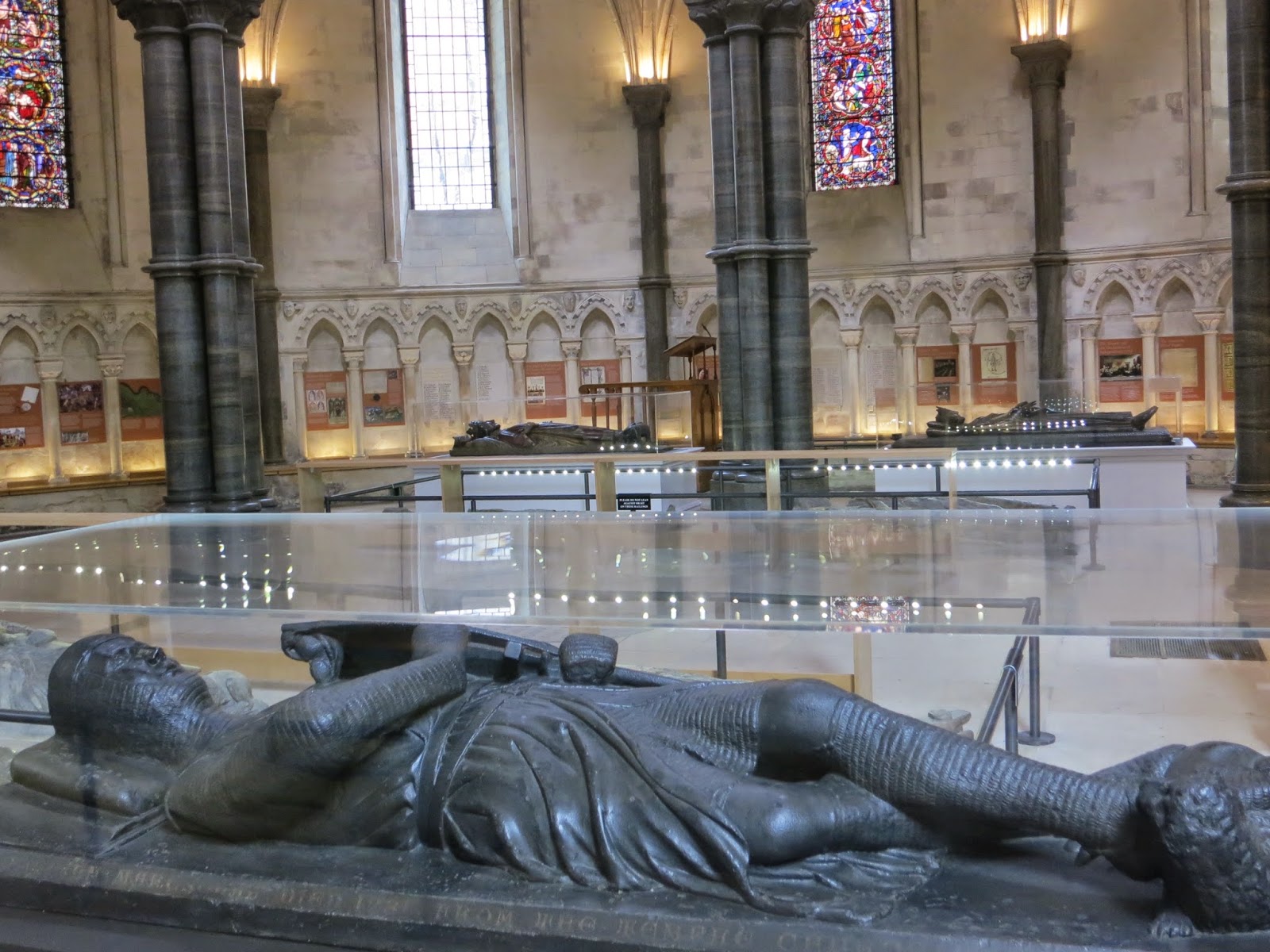
The link between Shakespeare and the Templars becomes stronger when we learn that Shakespeare lived in the Master’s Rooms at the Savoy Hospital, which was owned by the Templars, and was located near Temple Church (I regard “Shakespeare” as the pen name of the 17th Earl of Oxford).
We saw above that the Triple Tau is a Masonic symbol made up of three Ts (plus a concealed fourth T). Another Masonic symbol, known as “The Master of the Royal Secret,” is made up of four Ts:
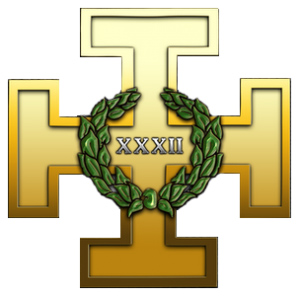
We also find four Ts in the Shakespeare monument. The poet is pointing to a quotation from The Tempest:

To make the quotation start with four Ts, the first line in the passage has been moved near the bottom. Here’s how the passage reads in The Tempest:
And like the baseless fabric of this vision,
The cloud-capped towers, the gorgeous palaces,
The solemn temples, the great globe itself,
Yea, all which it inherit, shall dissolve...
So the passage has been altered, doubtless by the Mason Alexander Pope, to call attention to the four Ts. Notice how the poet’s finger is pointing to the word “Temples” (as in Knights Templar, Temple Church, Order of Solomon’s Temple, etc.). The First Folio also emphasizes temples: in the preface, we find, “The most, though meanest, of things are made more precious, when they are dedicated to Temples.”
The First Folio is dedicated to the Herbert brothers, William and Philip. William was involved with the Freemasons; one website says he was Grand Master of the Freemasons from 1618 to 1630. Philip was married to Susan de Vere, youngest daughter of Edward de Vere, 17th Earl of Oxford, better known as Shakespeare. So it seems that Masons were involved with the First Folio, and also with the Shakespeare monuments at Stratford and Westminster Abbey.
Just as there are four Ts in the WestminsterAbbey monument, so there are four Ts in the Stratford monument:
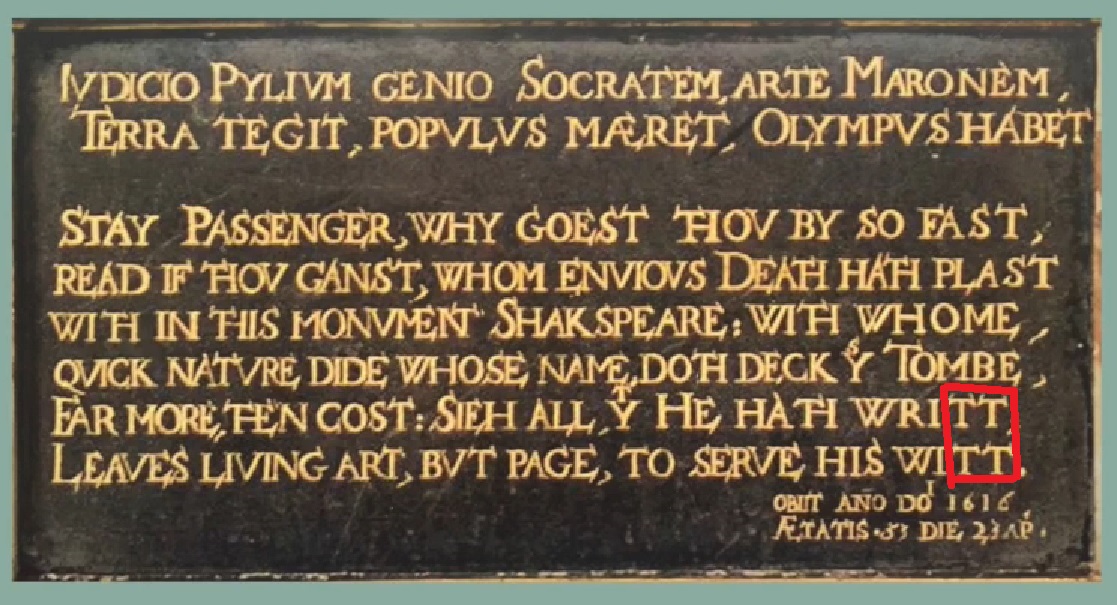
Shakespeare’s code name seems to have been “40,” which can be thought of as a pun on “four T.” The letter below is from King James to someone (Shakespeare/Oxford?) whose code name was “40” (the King’s code name was “30”).

Oxford’s connections to the numbers 17 and 40 may explain why the WestminsterAbbey monument was erected in 1740. It may have been possible to erect it earlier since “the Dean and Chapter had given leave to erect a monument to [Shakespeare] back in 1726.”1C Was the monument delayed so as to coincide with Shakespeare’s “special year,” 1740?
Let’s look again at the inscription with four Ts:

The first line of this inscription (“The cloud capt tow’rs”) has 17 letters. The “e” in towers seems to have been removed to make 17. If we combine 17 with 40 (“four T”), we have 1740, the year the monument was erected. Is 1740 a code for the 17th Earl of Oxford?1D
Perhaps you’re thinking, “three Ts, four Ts... so what?” John Dee, the famous Elizabethan magician, thought that the fourth T was the secret of the universe. “John Dee talks of the great mystery of the quaternary hidden within the ternary in his Monas Hieroglyphica of 1564, then he apologizes to God for spilling the beans!”2 We know that Shakespeare was interested in occult matters and corresponded with Dee, so it’s likely that Shakespeare read Monas Hieroglyphica. Perhaps that book inspired him to adopt “fourth T” and “40” as nicknames.
Did Shakespeare’s worldview resemble the Freemason worldview? In an earlier issue, I noted the parallels between Bruno’s worldview and the Freemason worldview — toleration, philanthropy, Egyptian symbolism, etc. Frances Yates believed that Bruno influenced both the Rosicrucians and the Freemasons. Shakespeare’s worldview resembled Bruno’s, thus Shakespeare’s worldview resembled that of the Rosicrucians and Freemasons.2A
Let’s look at how the “T motif” shows up in the Dedication of the Sonnets.

The Dedication has many odd features — the language, the capitalization, the periods after every word, the spelling of “onlie” and “insuing,” the mysterious “Mr. W. H.,” etc. The Dedication fairly cries out, “This is a cryptogram!” The Dedication “looks so like a cipher that one expert remarked that it cannot possibly be one!”3 Not only Oxfordians, but also Stratfordians like Leslie Hotson, have argued that the Sonnet Dedication is a cryptogram.4
John Rollett, who wrote an essay on the Dedication, contrasts it with typical dedications, such as this one:
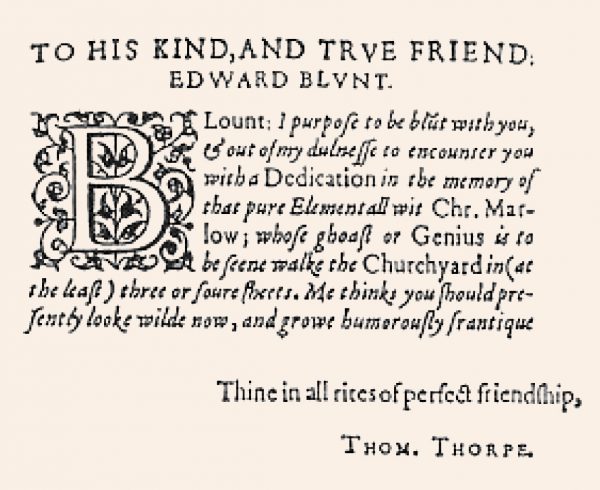
Note that both this dedication and the Sonnet Dedication purport to be written by Thomas Thorpe (T. T.), yet the two dedications are entirely different. Were they perhaps written by different people?
John Rollett studied cryptography — books like Mercury, or the Secret and Swift Messenger (1641), by John Wilkins. Rollett wondered if the Sonnet Dedication might be an “innocent letter code,” that is, a code that embeds a secret message in what appears to be an innocent text. In this kind of code, every 5th word (for example) is significant; when you combine these words, the hidden meaning emerges. Is this why the Dedication has a period after every word — the words were being counted as they were written?
Some innocent letter codes use two numbers instead of one. The text might be dated 5/3 (May 3), and you would find the secret meaning by counting 5 words, then 3 words, then 5 words, etc. Innocent letter codes were used as recently as World War II; prisoners would embed a secret meaning in what appeared to be an innocent letter.
Rollett wondered, If the Dedication is an innocent letter code, what is its number scheme?
| If we have to count words [Rollett wrote], there must be numbers somewhere.... There are no numbers in the Dedication.... Then I suddenly focused in on another peculiarity. The text is laid out in three blocks, which might suggest three numbers. The number of lines in each block is something that the cryptographer would have had under his control. The lines in the three blocks give us the three numbers: 6-2-4. |
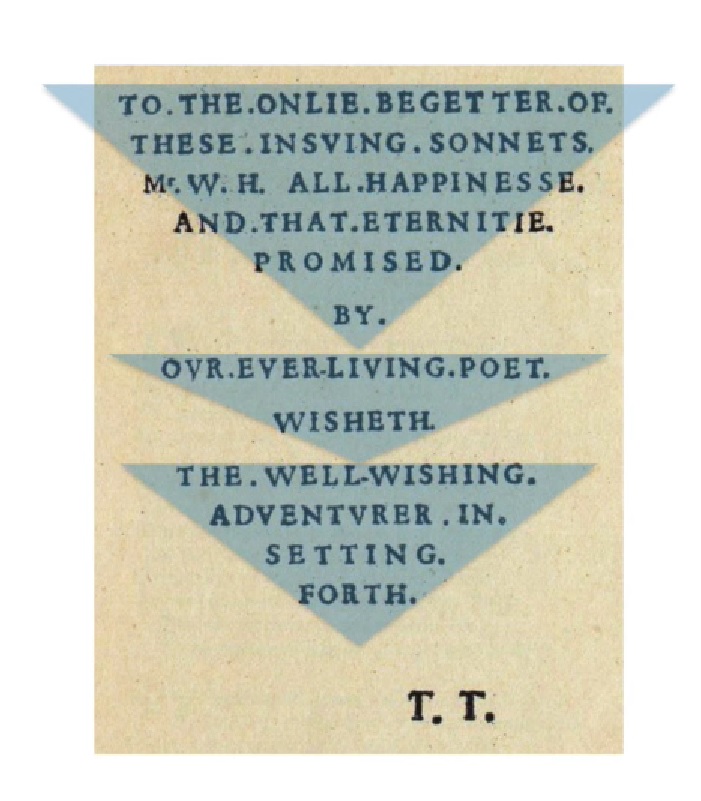
The name Edward de Vere is also 6-2-4, it has 6 letters (Edward), followed by 2 letters (de), followed by 4 letters (Vere). The following poem was written by Anthony Munday to Edward de Vere. It’s an acrostic — the first letters of each line spell out “Edward de Vere.”5
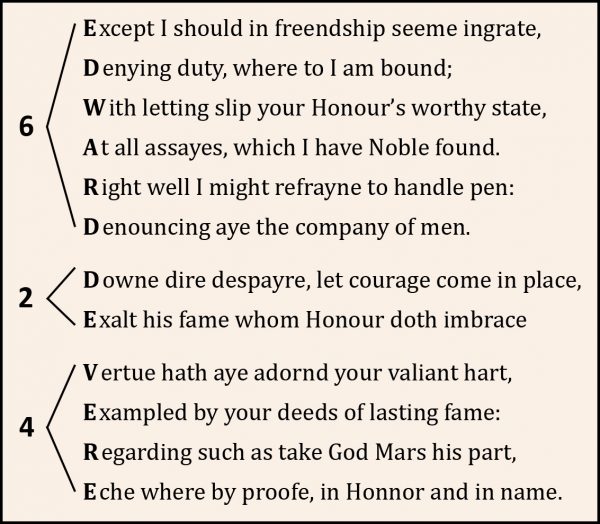
What happens when we test 6-2-4 on the Dedication, when we count 6 words, then 2 words, then 4 words, then 6 words, etc.? We get, THESE SONNETS ALL BY EVER THE FORTH T.

I read “EVER” as E. Vere, or Edward de Vere, and I read “FORTH” as fourth. (In 2005, I wrote about how de Vere was referred to as “ever.”) So now we have THESE SONNETS ALL BY E. VERE THE FOURTH T. Thus, the theme of “fourth T” appears in the Sonnet Dedication, as well as the WestminsterAbbey monument, the Stratford monument, Oxford’s code name, the date 1740, etc.
The Sonnet Dedication becomes yet another argument for Edward de Vere as the author of the works attributed to Shakespeare. The mountain of Oxfordian evidence just got a little bigger. Stratfordians struggle to explain the odd features of the Sonnet Dedication, but Oxfordians can now explain these features.
Does John Rollett deserve credit for “breaking the code” of the Sonnet Dedication? Rollett played a key role, but many Oxfordian discoveries, like discoveries elsewhere in the intellectual world, are joint achievements. Alexander Waugh played a significant role in de-coding the Sonnet Dedication, and in revealing the “fourth T” motif.
Who created the Dedication cryptogram? It’s likely that the cryptogram was created by John Dee.6 Whoever created the cryptogram must have been a master of cryptography because the Sonnet Dedication contains not only an “innocent letter code” but also a “grid code.” This grid code reveals a considerable amount of information in a text of only 144 letters.
A grid code appears to be a meaningless string of letters, such as
THSSAHSHEIEIIVLSNPAEPASHD
To de-code the message, the letters are arranged in a grid thus:

Now read down the left column, up the next column, etc.

The result is “The Spanish ships have sailed.” Dee regarded this as “a childish cryptogram such as any man of knowledge should be able to resolve.” Sometimes it’s called a “transposition cipher” because the letters are transposed, re-arranged.
The grid code of the Dedication isn’t childish, and isn’t easy to solve. This may be why it remained unsolved for centuries. John Dee may have been the only person alive at that time who could have made such a cryptogram. (A grid code is sometimes called a Cardano Grille, after the Italian polymath Girolamo Cardano. Cardano was born about 25 years before Dee, and in many ways he reminds one of Dee.)
Rollett began by arranging the Dedication’s 144 letters in a square of 12 columns, then he tried rectangles with various numbers of columns. In a rectangle with 15 columns, he noticed the name “Henry”:

Rollett also tried 18 columns:
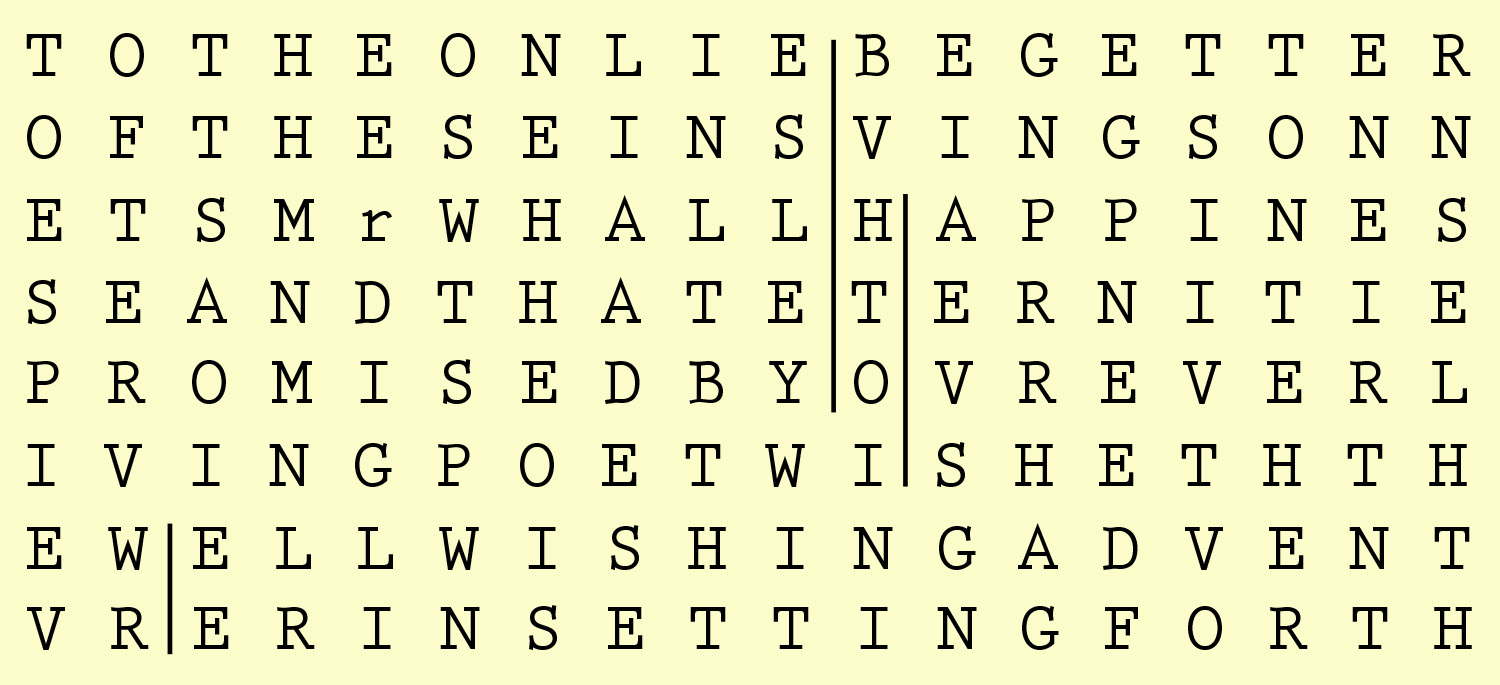
In the above grid, Rollett noticed
| split up into three bits, is the name WR-IOTH-ESLEY, spelt perfectly, just as it was always spelt officially. I first noticed the letters ESLEY in the middle column, and almost immediately the letters IOTH in the one next to it. At that moment I knew with absolute certainty that I would find the letters WR somewhere, and there they are, at the bottom of the second column. |
Is it possible that the name “Henry Wriothesley” is embedded in the Dedication by chance? Wriothesley was the 3rd Earl of Southampton, and he’s long been regarded (by Stratfordians as well as Oxfordians) as the Fair Youth of the Sonnets. It seems very unlikely that his name would appear in the “Dedication grid” by chance. I’ll leave it to mathematicians to calculate the odds of a chance occurrence (Rollett argues that the odds are one in 2 billion).
The occurrence of “Henry Wriothesley” in the grid makes it more likely that Mr. W. H. is “Wriothesley, Henry” as we’ve long suspected. As a result of the Essex Rebellion, Wriothesley was stripped of his title (3rd Earl of Southampton) and became simply “Mr.”
Perhaps you’re wondering, “Why not refer to him as Mr. H. W.? Why reverse the initials?” Reversing the initials might help the cryptogram, or it might conceal something that the author wanted to conceal, or Wriothesley might have been listed in prison records as “Wriothesley, Henry” (he was imprisoned in the Tower of London after the Essex Rebellion). Certainly the case for Henry Wriothesley as Mr. W. H. is stronger than the case for any other candidate.
In general, everything in the Dedication was done for the cryptogram. The surface text is bizarre and meaningless. The hidden meaning is rich in information.
By arranging the text in 19 columns, Alexander Waugh found information about the poet’s burial-place. In the image below, note the phrase “Lies Here” or “De Vere Lies Here.” Note also “Forth T” at the bottom and “TTT” to the right.

Earlier we found “Forth T” in the “innocent letter code” and decided it meant “Fourth T”. The Fourth T is often an upside-down T, and in the grid above, “De Vere” is an upside-down T.
According to Waugh, the cryptogram is telling us that the poet is buried in the south cross aisle of Westminster Abbey. This area is now known as the south transept, or Poets’ Corner. Waugh believes that Oxford/Shakespeare is buried under the Shakespeare monument. Around 1620, Percival Golding wrote that Oxford/Shakespeare was buried in Westminster, so the burial probably preceded the construction of the monument.7
If you look at column 7 of the grid below, you’ll notice SOVY ILE. Y can mean “th” (as in Ye Olde Shoppe = The Old Shop), so SOVY can be read as SOUTH. ILE can be read as “aisle,” so we have “South Aisle.” In columns 1-4, we have an anagram for Westminster, an anagram in the shape of the actual church. Standing alone in the middle of this anagram is the letter D, perhaps a clue to the identity of the cryptographer.
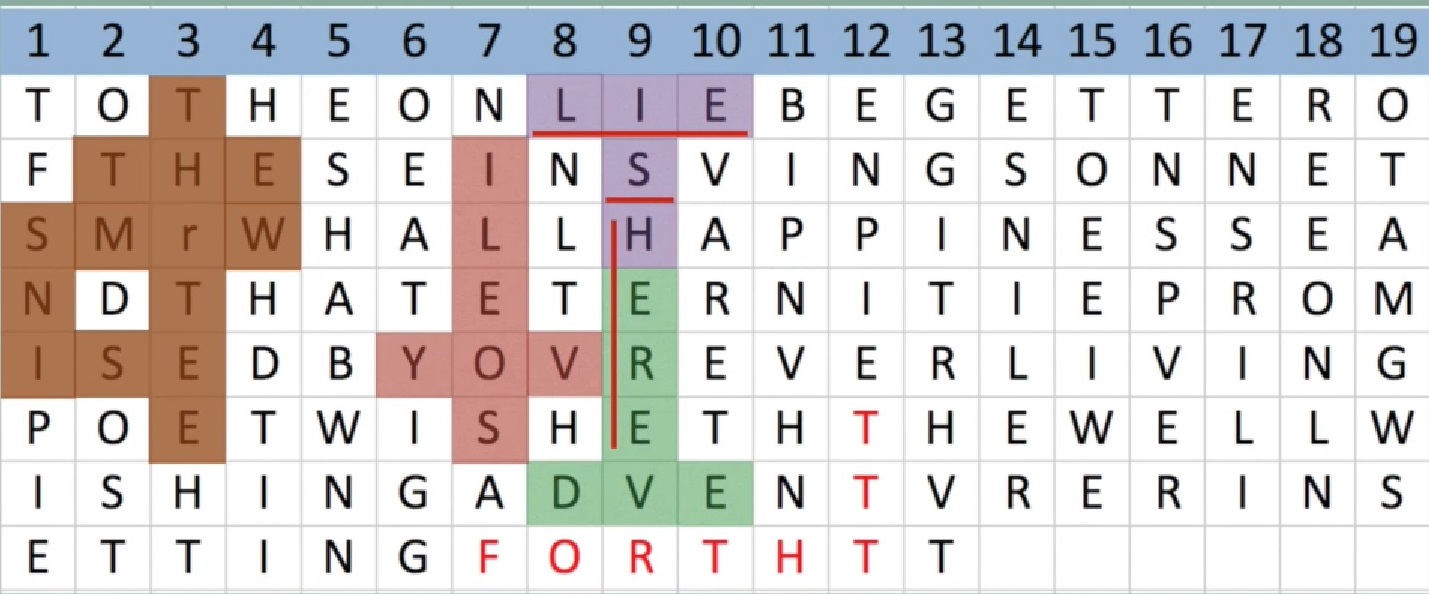
Videos by Alexander Waugh:
Where Shakespeare is Really Buried
Part 1
Part 2
Part 3
Part 4
What the Eye Cannot See (8-minute summary)
In Contemplation of the Cryptic Mind (4-minute summary)
Shakespeare’s Body Moved By Freemasons (41:31)
The Freemasons Who Knew Where Shakespeare Was Really Buried
Part 1
Part 2 (also known as “William Basse Knew”)
The Incalculable Genius of John Dee
What’s in a Name? Shakespeare’s Question Applied to Shakespeare
The Divinity of Man
John Dee, William Shakespeare and the Triangular Lodge at Rushton
John Dee’s Secret Patron Revealed
Edward de Vere: Saint or Sinner?
Monkey Business At Stratford
More Monkey Business At Stratford
2016 Talk on the Stratford Grave (42:40)
2017 Talk on the Real Grave (59:11)
Sweet Swan of Avon
Polimanteia (A Fair Youth, a Dark Lady and Shakespeare)
Revealing the Number that Unmasks Shakespeare
Scandal at the Abbey
Shakespeare’s Funerary Urn
Shakespeare Birthplace Trust Exposed
Vulgar Scandal: A Talk in Ashland
Adon’s Flower
Willobie His Avisa, Part 1
Willobie His Avisa, Part 2
Willobie His Avisa, Part 3 (also known as “Henry Willobie Knew”)
Debate With Stratfordian Jonathan Bate
Brunel University Talk
Shakespeare in Italy
Kepler’s SuperNova
Pictures that Reveal the True Father of Shakespeare’s Son
Was Marlowe Shakespeare’s Servant?
The Wilton House Monument
Ben Jonson’s Discoveries
Ben Jonson’s Encomium to Shakespeare
Who Knew the Identity of “Shakespeare”?
Ben Jonson Knew
Francis Meres Knew
Henry Peacham Knew
William Covell Knew
Richard Brome Knew
John Weever Knew, Part I
John Weever Knew, Part II
Thomas Porter Knew
William Davenant Knew
Thomas Bancroft Knew
John Warren Knew
William Marshall Knew
John Gerarde Knew
Richard Barnfield Knew
Abraham Holland Knew
Sir John Suckling Knew
John Cooke Knew
Thomas Edwards Knew
John Davies Knew
An Anonymous Poet Knew
Samuel Sheppard Knew8
George Vertue Knew
Andreas Gryphius Knew
Videos by David Shakespeare:
Pregnancy Portrait I
Pregnancy Portrait II
9
Nonsuch Palace I
Nonsuch Palace II
Was Henry Wriothesley the Son of the Queen? Part I
Was Henry Wriothesley the Son of the Queen? Part II
Is This the Face of Shakespeare?
Two Videos by Alan Green:
Dee-coding Shakespeare
The John Dee Cipher
John Anthony’s Oxfordian Videos
Phoebe DeVere’s Youtube videos and TikTok videos
© L. James Hammond 2019
feedback
visit Phlit home page
Become a patron via Patreon
make a donation via PayPal
| Footnotes | ||
| 1A. | As T had a hidden meaning, so too V had a hidden meaning. Edward de Vere sometimes referred to himself as “Double V,” a pun on “Deux Vere” and “de Vere.” In a preface to a work by John Lyly, Oxford signs himself, “Yours at an houres warning, Double V.”

When a W is written as a double v, there are two large V’s, and a third, smaller V formed by the overlap of the two large V’s.
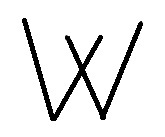
There’s also a hidden fourth V, upside-down, just as there’s a hidden fourth T in the “triple tau.” In the image below, I’ve highlighted the fourth V in red:

back | |
| 1B. | Alexander Waugh points out that “three times three” symbolizes Jesus Christ since three times three equals nine, which is IX in Roman numerals. In Greek, the initials of Jesus Christ are IX (Iota Chi), so the number nine (IX) can be seen as a symbol of Jesus. back | |
| 1C. | See the WestminsterAbbey website.
Perhaps you’re wondering, “Why would Templars be depicted with bent elbows and crossed legs?” Alexander Waugh suspects an allusion to the ChiRho, a symbol of Christ. The crossed legs would be the X or Chi, the bent elbow would be the P or Rho. Waugh believes that, after Shakespeare died, Francis Bacon took over the Master’s Rooms at the Savoy Hospital. It seems that both Shakespeare and Bacon were involved with the Templars, and these English Templars were probably the ancestors of the Freemasons; Waugh speaks of a “proto-Masonic” group. Why does the WestminsterAbbey monument hew to the Stratfordian line, at least on the surface? Why doesn’t it explicitly identify Ox17 as Shakespeare? In 1740, were there still reasons to keep the secret? If Alexander Pope knew that Ox17 was Shakespeare, why didn’t he divulge that in a poem or letter? In his ThomasBancroft video, Waugh argues that the scandal surrounding Edward de Vere (his parentage, his procreating, his adopting, etc.) was a threat to many members of the British establishment, since de Vere had numerous grandchildren, as did Southampton and Penelope Rich. Many British aristocrats wanted the truth about “Shakespeare” to be suppressed, even in the 1700s; a scandal involving their grandparents could tarnish them. At the bottom of the WestminsterAbbey monument, you’ll notice
William Shakespeare 1564-1616
Waugh says that this was added in 1972; he refers to it contemptuously as “graffiti.” back | |
| 1D. | As Ox17 played with “Double V,” so he played with W written as two V’s. This may have been a factor in his choice of “William Shakespeare” as a pseudonym. “William Shakespeare” is Double V followed by 17 letters. In the First Folio, the Double V is followed by “Illiam Shakespeare,” the first I in William being capitalized, as if encouraging us to count the letters by starting with I, Roman numeral one (see Waugh’s video, John Dee’s Secret Patron Revealed.)

Since V is the 20th letter in the Classical Latin Alphabet, Double V can be thought of as 40. So “William Shakespeare” could be translated 40-17 or 1740. Waugh finds a ChiRho symbol hidden on the title page of the Sonnets:
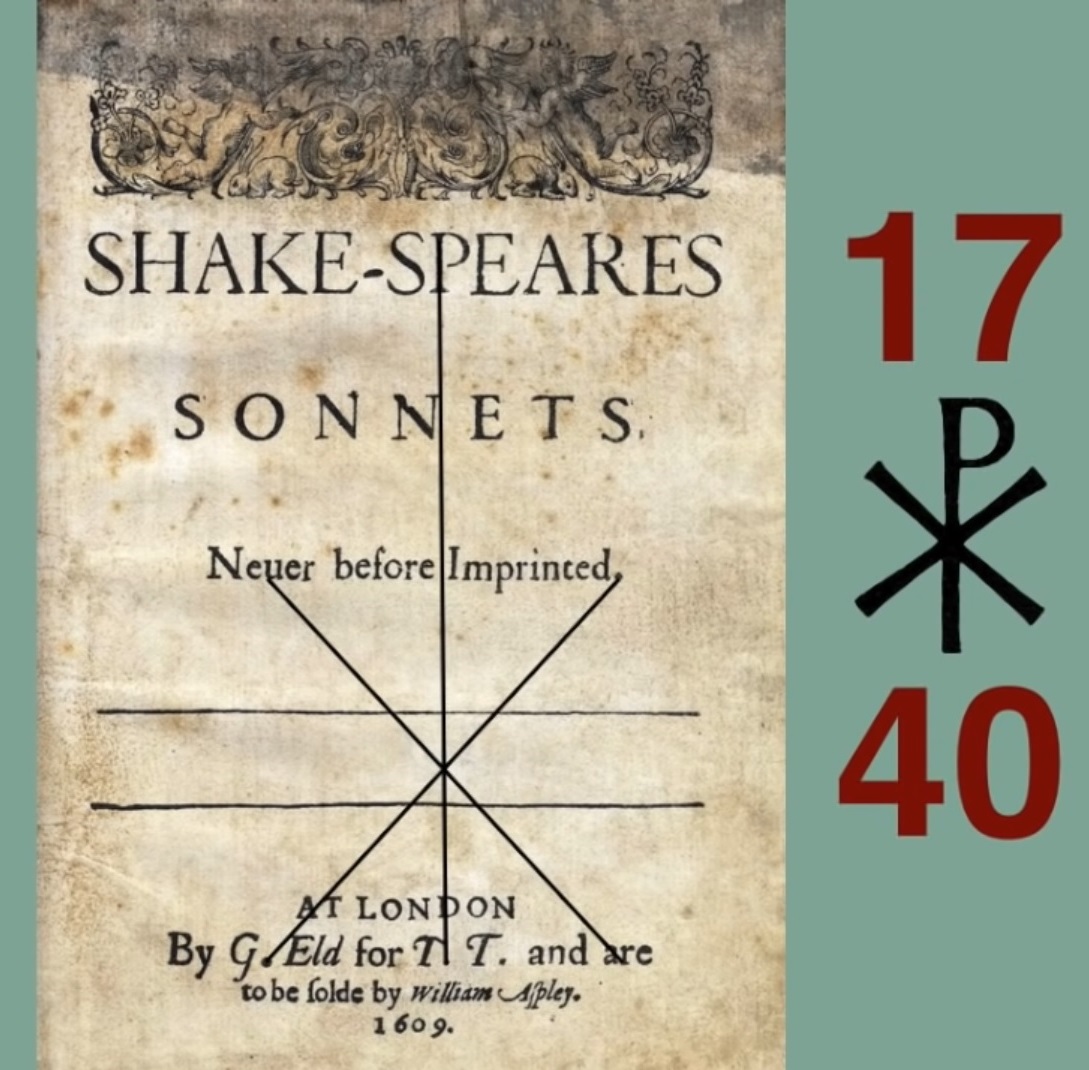
Waugh argues that ChiRho = 1740 because Rho is the 17th letter, and Chi has a value of 40 in NewTestament gematria. back | |
| 2. | Alexander Waugh, in an e-mail. Here are Dee’s words: “We demonstrate here that the Quaternary is concealed within the Ternary. O God! pardon me if I have sinned against Thee by revealing such a great mystery in my writings which all may read, but I believe that only those who are truly worthy will understand.” Perhaps Dee’s interest in the quaternary was the result of a study of alchemy. Jung was interested in alchemy and in the quaternary. Jung believed there were four functions in the mind/personality.
Perhaps the fourth T is concealed in a remark by Costard in Love’s Labor’s Lost. When Berowne says “three times thrice is nine,” Costard replies, “Not so, sir... We know what we know.” Alexander Waugh quotes Costard’s remark in his video “John Dee, William Shakespeare and the Triangular Lodge at Rushton”. In this video, Waugh argues that the Triangular Lodge deals with the theme of triple T, and with the hidden fourth T. back | |
| 2A. | We can think of 1740 as Oxford’s “personal number.” John Dee urged people to find their personal numbers. In his preface to Euclid, Dee wrote, “May we be led upward... toward the conceiving of Numbers absolutely that at length we may be able to find the number of our own name.”
One might say that Oxford had several personal numbers: 17, 40, 1740, and 153. 153 is a triangular number with 17 on each side of the triangle:

In the series of triangular numbers, 153 is the 17th (Wikipedia says it’s the 18th since it counts 0 as a triangular number). There are 153 sonnets (#154 is a mirror or shadow of #153). For more on the sonnets and triangular numbers, Waugh recommends a book by the Stratfordian Alastair Fowler, Triumphal Forms: Structural Patterns in English Poetry. Waugh notes that, on the Shakespeare monument, the monarchs form 153 — Elizabeth I, Henry V, and Richard III.
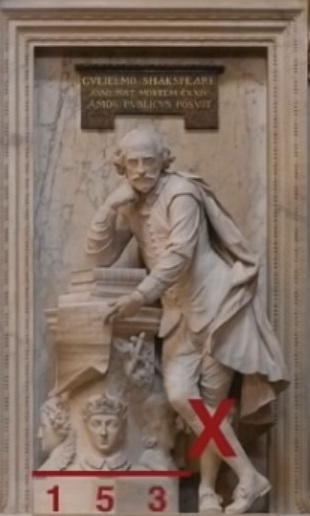
What was John Dee’s personal number? Dee’s first name had 4 characters, his last name 3; he always sought to find the quaternary hidden within the ternary, just as we found a fourth T hidden within the Triple Tau, and a fourth V hidden within the W. Dee used the triangle as a kind of signature, since the triangle is the Greek D or “delta.” D/delta is the 4th letter, and since the triangle symbolizes 3, Dee’s triangle signature is a blend of 3 and 4 (“the Quaternary is concealed within the Ternary”). Dee starts his preface to Euclid with a giant D inside a square; the D encloses a triangle, Dee’s coat of arms, and his glyph/image, which he called “Monas Hieroglyphica.”
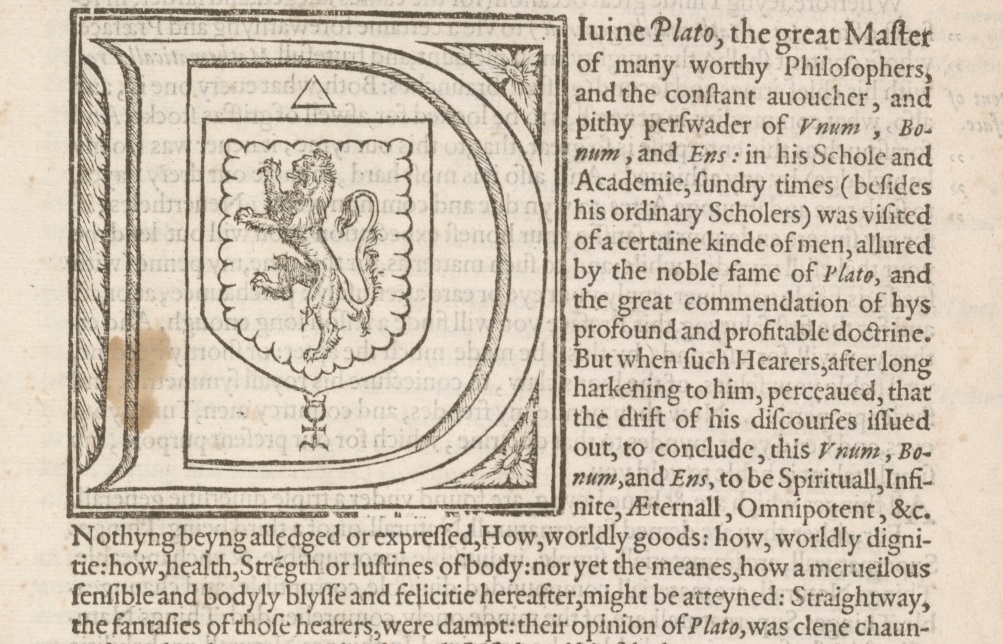
Dee ended his book on the Monas Hieroglyphica with “saith the Fourth Letter,” and his symbol, the triangle or delta.
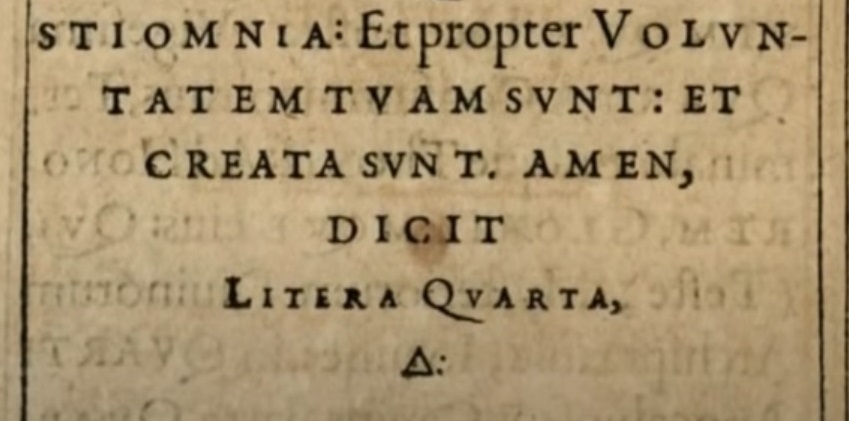
Dee thought we shouldn’t be satisfied with the Trinity, we should look for the hidden fourth element. Oxford was influenced by Dee; one of Oxford’s contemporaries said, “[Oxford] raised his voice against the sacred and most glorious Trinity affirming that the wise philosophers deride our ignorance in that great mystery.” As I said in an earlier issue, Hawthorne and Melville were interested in numerology, counting letters, etc. Like John Dee, they tried to find a better way to communicate than language. According to Wikipedia, “Much effort in [Dee’s] last 30 years went into trying to commune with angels, so as to learn the universal language of creation.”
Hawthorne and Melville “felt that ‘conventional language is not capable of rendering the divine which could only be revealed indirectly, that prophets spoke only in emblematic terms.’ American writers tried to transcend conventional language, tried to find a language that was ‘universal in space and time... the primordial condition when different people understood each other before the confusion of tongues occurred at the Tower of Babel.’” Hawthorne and Melville would have understood Dee’s effort to communicate through glyphs like the triangle and “monas hieroglyphica.” back | |
| 3. | See John Rollett’s essay on the Dedication. back | |
| 4. | “After analyzing many of the sonnets, [Hotson] says finally, ‘If one had to put the Sonnets into one word, that word would be Truth.’” This fits nicely with the Oxford Theory since the Vere family motto was “Vero Nihil Verius” (nothing truer than truth), and Edward de Vere often punned on Truth. back | |
| 5. | This poem is apparently the dedication of Munday’s book The Mirror of Mutability (1579). Here’s how it was originally printed: 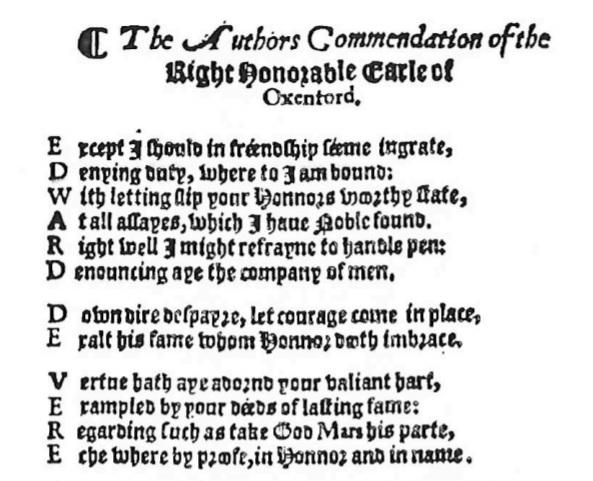
We should also note that 6/24 (June 24) is the date of de Vere’s death. back | |
| 6. | Wikipedia says that Dee died in “1608 or 1609.” Oxford/Shakespeare died in 1604. Dee probably worked on the Sonnet Dedication (and perhaps the Sonnet TitlePage) between 1604 and 1609. The Sonnets were published in 1609.
Dee may have also worked on an epitaph in Stratford:
Good friend, for Jesus’ sake forbear, When this epitaph is put into a grid with 17 columns (see image below), the name Dee appears twice, as well as the “NB” that Dee was fond of. “TTT” is in the 10th column. The letters in green are an anagram for “Vere’s T,” that is, the fourth T; the fourth T is an upside-down T.
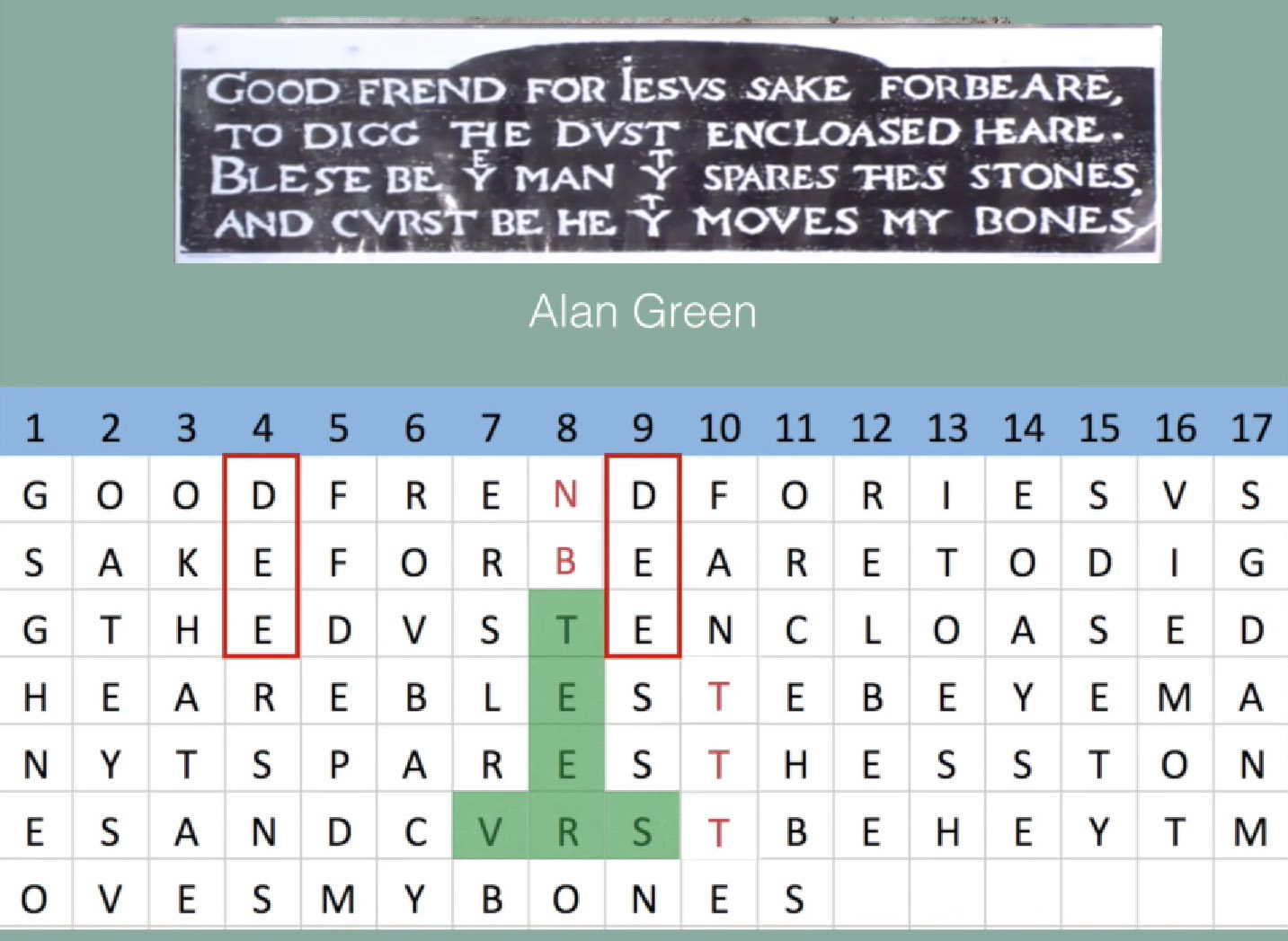
Note that Waugh has put “Alan Green” on the image; Green was apparently the first person to put this epitaph in a grid. Later we’ll look at a grid of the Sonnet Dedication, and we’ll find “TTT,” and an anagram for “De Vere” in the shape of an upside-down T. (In a video on Thomas Edwards, Waugh says that T has a value of 19 (since it’s the 19th letter), and therefore TTTT = 76. The word “Oxford” also has a value of 76, suggesting that Oxford is represented by the fourth T.) If Dee made this epitaph, it strengthens the argument that he made the Sonnet Dedication; it shows that he was involved with codes related to Oxford/Shakespeare. One person who would have been intrigued by the Shakespeare codes is Leo Strauss. Strauss believed that writers often conceal their meaning; Strauss hired an army code-breaker to read Machiavelli. In a recent issue, I discussed codes in the work of Hawthorne and Melville, codes that reflect a Hermetic-Christian worldview, just as the Shakespeare codes probably reflect a Hermetic-Christian worldview. This worldview sees the universe as a giant code, and believes that numbers have a mystical significance. The American code-breaker William Friedman studied the works of Baconians (Baconians are people who believe that Francis Bacon wrote the works attributed to “Shakespeare”). The Baconians thought they had found various codes in Shakespeare’s works, codes that pointed to Bacon as the real author. According to Wikipedia,
| |
| 7. | Golding: “Edward de Vere, only son of John, born the twelfth day of April, Anno 1550, Earle of Oxenford, High Chamberlain, Lord Bolebec, Sandford and Badlesmere, Steward of the Forest in Essex, and of the Privy Council to the King Majesty that now is. Of whom I will only speak what all men’s voices confirm: He was a man in mind and body absolutely accomplished with honorable endowments. He died at his house at Hackney in the month of June, Anno 1604, and lieth buried at Westminster.” Percival Golding was Oxford/Shakespeare’s cousin.
Let’s look again at the Stratford plaque:

Waugh believes that this plaque is telling us that Shakespeare/Oxford is buried in Poets’ Corner in Westminster Abbey. The plaque says, “Read if thou canst, whom envious Death hath placed with in this monument Shakespeare.” Waugh notes that there’s a space between “with” and “in,” suggesting that Shakespeare isn’t “within this monument,” rather he’s “placed with” certain people. Waugh construes the plaque to mean, “Read if thou canst, whom envious Death hath placed with Shakespeare...” The question is, Who is Shakespeare placed with? The two lines at the top of the plaque say that earth covers (terra tegit) Pylius with his judgement, Socrates with his genius, and Maro (Vergil) with his art. Waugh says that Pylius, Socrates, and Maro represent Beaumont, Chaucer, and Spenser, who are all buried in Poets’ Corner (Beaumont was often called “judicious,” Chaucer was often compared to Socrates, and Spenser was often compared to Vergil). So the plaque is telling us that Shakespeare is “placed with” those three poets in Poets’ Corner. Thus, the plaque reinforces Percival Golding’s remark that Ox17 is buried in Westminster Abbey. Those who doubt Waugh’s interpretation need to explain why, if Shakespeare is simply “within this monument,” the visitor is told to “Read if thou canst,” as if something requires interpretation. And why the Latin couplet at the top? And why a space between “with” and “in”? Perhaps one way to resolve the issue is to look inside, and under, the WestminsterAbbey monument.
Click here for a video in which Waugh argues that a key-shaped message is concealed in the Stratford plaque. back
| |
| 8. | I have one gripe with this video. When Waugh discusses Sophocles, he equates “cles” with “key.” In my view, “cles” is from the Greek “kleos,” meaning glory/honor/fame. Glory was important in Greek ethics, and parents often put “cles” in their children’s names. Pericles, for example, means “widespread fame.” “Sophocles” should probably be translated “famed for wisdom.”
Waugh equates “Sopho” with “cleverness,” but I think it should be translated “wisdom” or “knowledge.” Philosophy (philo sophos) certainly isn’t “love of cleverness,” it’s love of wisdom or knowledge. So “Sophocles” can’t mean “clever key,” it would have to be something else, perhaps “wise key.” But that makes no sense, so I think we should stick with “famed for wisdom.”
If you accept my view, if you substitute “glory” for “key,” if you substitute “famed for wisdom” for “clever key,” I don’t think that would weaken the rest of Waugh’s argument. He could still argue that SHAKESPEAR ARISTOPHANES means “an aristocrat is revealed by ‘Shakespeare.’” Or he could argue that Sheppard is simply comparing Shakespeare to Euripides, Sophocles, and Aristophanes. Perhaps Sheppard is saying, “Shakespeare is unequalled in the contemporary world, and in English poetry, but he has some rivals in ancient Greece.” back | |
| 9. |  The above painting is at Hampton Court, twelve miles from the center of London. The official site calls it, “Portrait of an Unknown Woman,” but David Shakespeare says it’s a portrait of Elizabeth, and it shows Elizabeth pregnant. Since Elizabeth’s pregnancy was a delicate, controversial subject, her pregnancy isn’t obvious, it’s barely noticeable. Indeed, the whole painting is controversial, its meaning obscure. According to David, the stag represents Ox17, and the poem in the lower right is consistent with the style and themes of Ox17’s poetry. Ox17 probably commissioned the painting to express his view of the Queen. The painting enabled Ox17 to circumvent the book-censors. David says there’s a copy of the painting floating around, he hopes that someone will come across it and notify him. The copy helps us to see how the original has been altered and over-painted. David’s videos contain an interesting discussion of Nonsuch Palace, which was built by Henry VIII, and often visited by Elizabeth. back | |